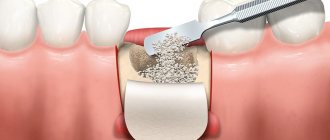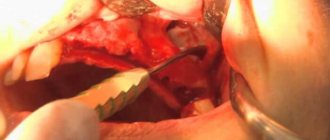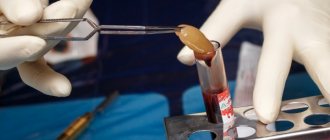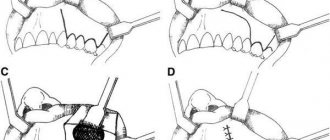Before deciding on dental implantation, the doctor evaluates the volume of bone tissue. If there is a deficiency, a bone grafting operation is recommended, which often frightens the patient and forces him to refuse dental implantation altogether. What should you really be wary of when augmenting bone tissue and is it possible to do dental implantation without it? Are such operations really that scary and are they always necessary? says Dmitry Valerievich Levin, Candidate of Medical Sciences, Chief Physician and Implant Surgeon at the Doctor Levin Center for Private Dentistry in Moscow.
The importance of bone grafting in dentistry
One of the main advantages of implantation over classical prosthetics is that it prevents bone loss in the area of missing teeth. The jawbone constantly needs stimulation, which occurs as a result of the pressure exerted on it during the chewing process. However, after the loss of a tooth, the bone ceases to receive the proper load, as a result of which it begins to decrease. Conventional dentures cannot prevent bone tissue resorption, since they mainly put pressure on neighboring teeth, and not on the area of the missing tooth. Only an implant can stop this natural process. During dental implantation, bone tissue receives the necessary load and does not lose volume, which allows you to avoid numerous negative health consequences and maintain the aesthetics of your smile. In case of prolonged absence of a tooth, as a result of which the jawbone has begun to atrophy, bone grafting comes to the rescue.
What is bone grafting for dental implants?
Bone grafting in dental implantology is the augmentation of bone tissue, which is often necessary to perform turnkey dental implantation. On average, 3 to 6 months after the loss of a tooth, the process of bone tissue atrophy begins at the site of its removal, due to the fact that the bone ceases to bear the load. This process reaches its peak after about a year, and if you do not contact an implantologist immediately after removing unhealthy teeth, there is a high probability that additional bone augmentation surgery will be required later. It should be noted that plastic surgery, even in situations where there is a lack of jaw bone tissue, is not always required and not for everyone. The decision on the need for it will be made by the doctor, based on the situation of the individual patient.
There are cases when the bone tissue in the place of a missing tooth remains unchanged for many years, but this is rather an exception to the rule. More often, quite pronounced bone atrophy and even tilting or displacement of teeth towards the defect are observed.
Photos of bone grafting at various stages of its implementation
Why does atrophy occur?
Removal of dental bone tissue is not carried out on purpose. Atrophy is almost always the result of a long “downtime” of a certain area of the dentition. Among the factors contributing to the problem:
- advanced inflammatory gum diseases;
- periodontal damage;
- purulent inflammation of the maxillary sinuses;
- acute/chronic pathologies of the thyroid gland;
- vitamin D deficiency;
- long-term use of glucocorticosteroids and some other medications;
- congenital anomalies of the upper or lower jaw;
- hereditary tendency to the disorder.
But most often, bone tissue subsides after tooth extraction. This is the main cause of the disease. While chewing food, the blood supply to the bone increases. It is due to this that its original volume is preserved. After tearing out the unit, the empty area is no longer subject to the necessary chewing load. Local blood supply deteriorates. Then the bone decreases. In one year, its volume decreases by approximately 25%.
What types of bone grafting are there?
Bone grafting of the lower jaw in the lateral regions is necessary in case of a decrease in the height and width of the alveolar process and a reduction in the distance to the mandibular canal. Significant loss of bone volume in the lower jaw can result in a change from the normal bite to a mesial bite (where the lower jaw moves forward).
Bone grafting of the alveolar process of the upper jaw is associated with bone resorption and the formation of a thin and sharp alveolar ridge. The difficulties of plastic surgery in this area are associated with the task of achieving an optimal cosmetic result.
Bone grafting of the lateral sections of the upper jaw is called sinus lifting, since the maxillary sinuses, or sinuses, are located in this area. There are closed and open sinus lifts, and they differ in the way they penetrate the bone.
Make an appointment
right now!
Levin Dmitry Valerievich
Surgeon, Implantologist, Maxillofacial surgeon
Is implantation possible without osteoplasty?
In some cases, implantation without osteoplasty is possible, but more often it is a temporary solution or an operation without a guarantee.
Installation of mini implants
Implantation using mini-implants is usually performed with complete edentia. In this case, there are no requirements for the height and density of the jawbone. Implants of reduced size are fixed in the gums in a minimally invasive way without involving bone structures. Serve as additional support for conventional removable dentures. However, this is a temporary solution; such structures are short-lived.
Application of one-stage implantation protocols
Some clinics practice installing implants using immediate loading protocols - All-on-4, All-on-6, basal complex. The first two are used in cases of complete absence of teeth, basal - from 3 teeth in a row.
To install artificial roots, areas of the jaw are selected where at least a minimum volume of bone is still preserved. Since thin implants are used, they are fixed at an angle in the area of the chewing teeth to create a large area of contact between the artificial root and the thinned bone. With basal implantation, the deep layers of the jaw are involved, which are not subject to atrophy. The prosthesis is fixed immediately.
We do not recommend such experiments, since they contradict the entire law of biomechanics. Any orthopedic structures must be supported by implants installed in parallel. In this case, there will be no overload in the area of connection between the prosthesis and implants. In addition, basal implants fail in 40% of cases. It is better to grow the bone, wait for engraftment and carry out implantation without risks.
Other methods
In some cases, osteoplasty is avoided due to tricks, which we also do not recommend:
- When installing shortened implants to restore anterior teeth. This is due to the fact that in the frontal region of the jaw there is a slight decrease in bone height. But this approach does not guarantee success, since artificial roots of small diameter, but always of the required length, must be installed for the front teeth.
- When installing rods in the area of the posterior wall of the nasal sinus. The location outside the sinus allows the use of traditional implant models due to the greater height of the bone in this section. But when calculating the placement of implants, the law of distribution of chewing load must be taken into account and the correct distance between several roots must be observed.
- When using the thinnest and shortest rods from a number of classic ones on the bottom row, bypassing the trigeminal nerve. This option will not ensure the fulfillment of the functional responsibilities of the roots. With chewing loads, they can become loose or even break.
What materials are used for bone grafting in dentistry?
Both natural and synthetic materials, which have similar capabilities for engraftment and replenishment of bone volume, can be used as a bone tissue implant. Synthetic materials are made based on hydroxyapatite or calcium phosphate. As a rule, they are produced in powder form and are successfully used in world practice.
Autogenic
For bone tissue augmentation, the best material is autogenous, that is, your own bone sections taken from the donor area. Such an area, as a rule, is the chin or the area of the lower jaw in the area of the wisdom teeth. An autogenous graft takes root better than others, but its use is associated with an additional operation to collect donor material.
Allotransplantation
In addition to autotransplantation, in some cases allotransplantation is used, when bone material is taken from another person who bequeathed his organs for medical purposes. In this case, the donor material is carefully selected, sterilized and processed, and the recipient’s body eventually accepts such bone material as its own and successfully restores the lost bone.
Xenotransplantation
When people talk about xenotransplantation, they usually mean the transplantation of bone tissue from animals, usually cattle. The bones of cows and bulls are carefully processed, sterilized, and manipulated to make them compatible with the human body. Such transplants also take root well.
Alloplasty
This is the most modern method, which is most often used by implantologists around the world. The material used is a special bone powder that stimulates tissue growth. This is the least traumatic and patient-friendly method of bone tissue augmentation.
How to recover
Most often, to eliminate the effects of atrophy, dentists prescribe surgery. Medicines cannot correct the situation. They often turn out to be useless, even if they just need to slow down regression.
Among the most effective methods of returning the original volume of the bone structure:
- Sinus lift. Suitable for working on the upper jaw only. During the intervention, the surgeon raises the bottom of the maxillary sinus to the height required for implantation. He fills the resulting cavity with special shavings. After sinus lift, you can proceed to implantation.
- Osteoplasty. An operation to transplant a small area of donor/own material. If necessary, the doctor can use synthetic material. The technique is popular because it takes little time. At the same time, the risk of rejection of the transplanted area is minimal.
- Tissue regeneration. An innovative technique that involves growing new bone tissue directly in the patient’s mouth. To obtain the desired result, a special protective membrane is placed in the deformed area. It creates a space in which regenerative processes take place as actively as possible.
- Transplantation of the prepared block. Indicated if you need to restore a large atrophied area of the jaw. The doctor takes material for transplantation from the patient’s bone, obtained from the palate, beard. It is also possible to use donor blanks.
The specialist decides which of the available methods is suitable for a particular patient on a personal basis.
What complications occur during bone grafting surgery?
Bone grafting in dental implantology varies greatly in complexity. This could be a major transplantation of bone blocks or some minor manipulation using osteoplastic material. But any operation requires the skill of a professional and his close attention to each patient individually. Any mistake in the bone tissue augmentation procedure is fraught with complications in the form of wound inflammation, suppuration or rejection of the bone block.
Many consider soft tissue swelling to be a complication after bone grafting. However, this is rather a natural reaction of the body to the surgical intervention. Swelling, as a rule, occurs and increases during the first two to three days, and then gradually subsides. Local hematomas may also appear.
Regardless of the volume of operations, all manipulations must be planned in such a way that the patient can endure them comfortably.
Is it possible to perform bone augmentation at the same time as dental implantation?
Of course, modern technology for dental implantation suggests that bone grafting of the jaw and installation of an implant can be carried out in one visit, but a lot in this matter depends on the clinical case and the doctor. For example, some specialists try to separate everything: first remove the tooth, then do bone grafting, and only after that carry out implantation. But what is it like for a patient to undergo surgery in the same place several times? Obviously, no one wants to experience this kind of stress. Therefore, bone grafting and implantation should be separated only in extreme cases, when bone tissue is missing in a sufficiently large volume. For the patient, of course, it is preferable to install an implant simultaneously with bone grafting of the jaw, but the decision on the order of the procedures must be made by the doctor, based on the specific case.
What prices can you expect for bone grafting in dentistry?
As a rule, the cost of bone grafting of the lower or upper jaw directly depends on the quantity and quality of the required bone material. Let's say, prices for a closed sinus lift in Moscow start from 15,000 rubles, for an open one - from 25,000 rubles, and taking your own bone material costs around 30,000 rubles. Each case is unique, and how much your bone grafting will cost will only be known at an appointment with a specialist.
Publisher: Expert magazine about dentistry Startsmile.ru
What are the complications of installing implants in case of bone atrophy?
In conditions of insufficient bone tissue, the implant will not be able to be firmly fixed, which can lead to its loss. Additional risks arise on the upper and lower dentition, which differ due to the structure of the jaws and the quality of the bone tissue.
On the upper jaw
Due to the lower chewing load, the bone tissue of the upper jaw is more loose compared to the lower jaw. Therefore, when teeth are lost, atrophic processes occur faster. If implantation is not carried out on time, after six months the bone loss will be more than 60%, in the area of the maxillary sinuses - about 80%. Installing an implant in such a situation is risky. If the rods are longer than the remaining bone, there is a high risk of damage to the bottom of the nasal sinuses, which is dangerous due to infection and the development of sinusitis.
On the lower jaw
The bone tissue of the lower jaw is more dense in structure. When teeth are lost, it is absorbed less intensively. However, a long-term lack of solution to the problem subsequently makes implantation difficult. This is due to the close location of the trigeminal nerve, which is responsible for the functionality of the lower part of the face. When the gums sag, the distance to it becomes minimal. Installation of implants is fraught with nerve damage, loss of sensitivity of the lips, cheeks and tongue.
Related articles:
- Implantation of upper teeth
- Implantation of lower teeth
- Treatment guarantees











